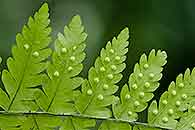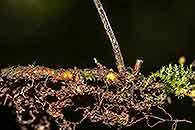Arthropteris monocarpa (Cordem.) C. Chr.
Synonyms |
Arthropteris anniana Lawalrée |
|---|---|
Common name |
|
Description |
Rhizome widely creeping, c. 2 mm in diamater; rhizome scales subcircular to broadly ovate in outline, margins entire, up to 1.5 mm long, brown. Fronds monomorphic, spaced apart, erect to arching, thinly herbaceous. Stipe up to 18 cm, articulated near the base, pale brown, glabrous at maturity. Lamina deeply 2-pinnatifid and a pinnatifid terminal segment, oblong-lanceolate in outline, up to 33 × 12 cm; pinnae 13-17 alternate pairs, oblong-lanceolate in outline, apex tapering into a long drawn-out point, very broadly oblong at the base, basal 2 pairs of pinnae slightly reduced, subsessile to shortly petiolate, articulated to the rhachis, up to 7.5 × 1.5 cm; ultimate lobes oblong with rounded apices, up to 1 x 0.3 cm, hairless but with sparse white hairs along the veins, costules and costae below, white dots on the upper surface absent; rhachis with minute pale brown hairs. Sori circular, usually solitary in each lobe, but sometimes up to 6 per lobe, up to 1.5 mm in diameter; indusium c.1 mm in diameter, membraneous, entire. |
Notes | Looks very much like A. orientalis which has a stipe that is articulated in the upper half and a row of white dots near the margins on the upper surface of the pinna lobes. A. orientalis is a woodland species while A. monocarpa is a forest fern. |
Derivation | monocarpa: with one fruit; refers to a single sorus on each lobe of the frond, however this species can have up to 6 sori per pinna lobe. |
Habitat | Shade in evergreen or riverine forest, usually on trunks of trees or treeferns, also on rockfaces or steep banks. |
Distribution worldwide | Africa, Madagascar, Comoro Isl. and Réunion. |
Distribution in Africa |
Angola, Burundi, Cameroon, Congo, Dem. Republic of Congo, Equatorial Guinea (incl. Bioko), Ethiopia, Ghana, Guinea, Ivory Coast, Kenya, Liberia, Malawi, Mozambique, Nigeria, Rwanda, Sierra Leone, South Africa, Sudan and South Sudan, Swaziland, Tanzania , Uganda, Zambia, Zimbabwe. |
Growth form |
Epiphytic, lithophytic, terrestrial. |
Literature |
|



